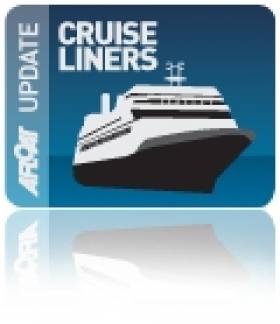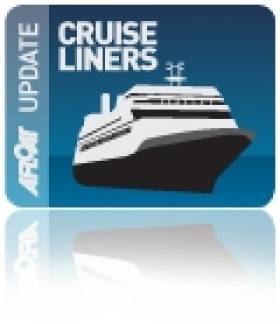Displaying items by tag: Peter Deilmann's Deutschland
Chartered Cruiseships Gather for Olympic Games
#OLYMPIC CRUISESHIPS - Peter Deilmann's cruiseship Deutschland (1998/22,496grt) which called to Dublin Port at the weekend is en-route in the English Channel, having departed Plymouth bound for London, where she is set to became a floating hotel during the Olympic Games, writes Jehan Ashmore.
With less than four days to go to the start of the games, the 480 passenger capacity cruiseship has been chartered by the German Olympic Sports Federation. The vessel is scheduled to dock in West India Docks at the foot of the towering banking HQ offices in Canary Wharf.
Last year she made a trial visit, where she became the largest ever vessel to enter through the West India Dock lock. So with her return, she joins Fred Olsen Cruise Lines 929 passenger Braemar (1993/24,344grt) which as previously reported on afloat.ie is also on charter during the sporting spectacle, to the London Organization Committee of the Olympic and Paralympic Games (LOCOG).
The Bahamas-flagged vessel, formerly launched as Crown Dynasty for Crown Cruise Line, is moored in the East London Dock's Albert Dock basin at a berth facing opposite to the runway of London City Airport.
Astern of this vessel is Gemini (1992/19,093grt) which by coincidence is her sistership, having served as Crown Jewel, as both cruiseships were ordered by Crown Cruise Line from the Spanish shipyard of Union Naval de Levante in Valencia. However since change of ownerships, the Braemar was lengthened for her current operator.
As for Gemini likewise, she too has been chartered to LOCOG to accommodate personnel over the course of the games.
Tomorrow Noble Caledonia's 114-passenger Caledonian Sky is due in London too, the former Hebridean Spirit (1992/4,200grt) made a once-only cruise/promo call to Dun Laoghaire Harbour around a decade ago. The large yacht-like vessel will be accompanied by other 'private' luxury motor-yachts during the games, which were last held in the British capital in 1948.
Three’s A Crowd as Liners Line-Up in Dublin
#TREESOME CRUISECALLS – This morning three cruiseships arrived into Dublin Bay and all within less than an hour. Currently the trio are berthed closely together in the centre of Dublin port, which this year expects to see around 90 such vessels visiting this season, writes Jehan Ashmore.
First to arrive was Holland America Line's Prinsendam (1988/37,983grt) from Liverpool, followed by Swan Hellenic's Minerva (1996/12,449grt) from Portsmouth and lastly Peter Deilmann's Deutschland (1998/22,496grt) from Douglas.
In 2011 around 200 large cruise vessels visited Irish shores carrying more than 308,000 passengers and crew. The cruise sector in fact has doubled in terms of visitors, in just over 7 years when 142 cruise ships called in 2004 bringing more than 146,000 passengers and crew.
Large ports such as Dublin, Cork and Belfast handled over 85% of the total cruiseship visitor numbers in 2011. Of these ports only Dublin saw an increase, leaving the others remaining relatively unchanged. However, as previously reported on Afloat.ie, the opening earlier this year of Titanic Belfast is attracting more cruise calls to Belfast.

























































